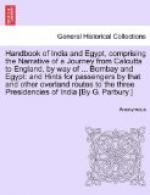[Illustration: The seller of “Malpurwa jaleibi".]
Now, as the Faithful wend their way homewards, bands of cheerful millhands hasten past you to the mills, and are followed by files of Koli fisherfolk,—the men unclad and red-hatted, with heavy creels, the women tight-girt and flower-decked, bearing their headloads of shining fish at a trot towards the markets. The houses disgorge a continuous stream of people, bound upon their daily visit to the market, both men and women carrying baskets of palm-leaf matting for their purchases; and a little later the verandahs, “otlas,” and the streets are crowded with Arabs, Persians, and north-country Indians, seated in groups to sip their coffee or sherbet and smoke the Persian or Indian pipe. Baluchis and Makranis wander into the ghi and flour shops and purchase sufficient to hand over to the baker, who daily prepares their bread for them; the “panseller” sings the virtue of his wares in front of the cook-shop; the hawkers—the Daudi Bohra of “zari purana” fame, the Kathiawar Memon, the Persian “pashmak-seller” crying “Phul mitai” (flower sweets), start forth upon their daily pilgrimage; while in the centre of the thoroughfare the “reckla,” the landau, the victoria and the shigram bear their owners towards the business quarters of the city. “Mera churan mazedar uso khate hain, sirdar,” and past you move a couple of drug-sellers, offering a word of morning welcome to their friend the Attar (perfumer) from the Deccan; while above your head the balconies are gradually filling with the mothers and children of the city, playing, working, talking and watching the human panorama unfold before their eyes.




